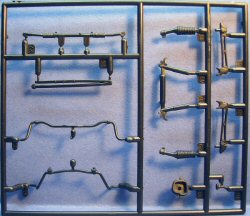
Revell 1/25 2006 Ford Mustang GT Kit First Look
By Stephen Sutton
| Date of Review | January 2006 | Manufacturer | Revell |
|---|---|---|---|
| Subject | 2006 Ford Mustang GT | Scale | 1/25 |
| Kit Number | 2839 | Primary Media | Styrene |
| Pros | Engine, Interior | Cons | Chrome Wheels |
| Skill Level | Intermediate | MSRP (USD) | $13.96 |
First Look
 |
 |
 |
 |
 |
 |
 |
 |
 |
 |
 |
 |
 |
 |
 |
At 60 plus years and counting, the Ford Mustang is showing no signs of middle-age aches and pains. In fact, you could say that this pony car has been reborn with a healthy dose of the same type of magic that made the original Mustang such a smash hit when it was introduced at the New York Worlds Fair in April, 1964. At the time, Ford was in need of some excitement in its line. Bolstered by a multi-million dollar ad blitz, the Mustang almost single-handedly changed the way Americans looked at their cars. It was the right product at the right time.
The date was April 17, 1964. Intermediate sized muscle cars with big block engines were gradually replacing the full sized muscle car. Lee Iacocca, Ford's General Manager, had always envisioned a small sports car to be the next hot item in the street wars. Ford decided that instead of improving their lackluster intermediate, they would do the competition one better and introduce a whole new breed of automobile, the pony car.
Originally designed as a two-seater in the European tradition, Iacocca realized that true success depended on volume sales. Therefore the Ford Mustang was introduced as a 1965 model that was based on the compact Falcon to lower production costs.
It came with an obligatory back seat and a multitude of options that would give the buyer an opportunity to customize their purchase, and generate extra profits for Ford. Plymouth faithful stress that their Barracuda beat the Ford Mustang to market by two weeks. But it was the Mustang, which racked up over 22,000 sales its first day and one million sales in its first two years, that turned the market and people's attention to the pony car. The pony car class that the Ford Mustang helped create is the only class of muscle car that still exists today.
Engine:
The engine represented in this kit is a 4.6L 3V SOHC V8 motor with a Tremec 3650 manual gearbox, comprised of over 22 parts in gray styrene, six steps are required to assemble this GT motor. A separate dual exhaust system is nicely reproduced as a single part, some clean up will be required on the mold seams. The battery, windshield washer, radiator overflow and power steering reservoirs are molded into the engine compartment. Air Filter intake is provided as a separate part. The serpentine drive belt arraignment matches perfectly with the real 4.6 V8 engine. Decals are included for the radiator shroud and underside of hood. Overall this kit has a very nice representation of the 300 horsepower motor.
Chassis:
The Suspension is nicely represented with the larger front and rear stabilizer/sway bars found on the GT’s. Front independent suspension and rear control arms and axel are nicely recreated. Front and rear disk brakes assemblies are included. The chassis has molded in fuel line, fuel filter, brake lines, and fuel tank.
Wheels and Tires:
The kit includes the new 17” wheel and tire combination. These are found on the chrome tree, the production GT had an option for these wheels to be machined aluminum, so you will need to spray a coat of clear semi-gloss to simulate the same finish. The tree attachment points flow into the wheel rim edge so extra cleanup will be necessary to remove the tree attachments and therefore loss of chrome plating in the edge the rims in fours places. The tires represent the low profile P235/55ZR17
Interior:
The Pony’s interior includes the options for the “my color” instrument color package with four different decal options for the instruments. On the dash includes a very accurate 1,000-watt audio system found in the GT. The seats represent the fabric sport bucket option, but no pony decals are provided for the insert portions of the seats. A stick shift, parking brake and console lid as well as visors and rear view mirror are all separate parts. Separate door panel are also included.
Body:
The body is outstanding, no warpage, sink marks or mold lines are present in my example. Two separate trees of clear styrene is provided for the glass upfront and back.
A plus to this body is its all molded in one piece, so you don’t have to glue on the front and rear clips as most other kits. A rear spoiler is also provided.
Decals:
The decals are crisp and in register. Options for using either dark blue or silver racing strips are on the sheet. Four different instrument clusters are provided as well as all the decals for the engine compartment. A nice touch is a decal for the rear gas cap.
All parts trees came wrapped separately as what is turning into a standard practice by Revell-Monogram with its most recent kit releases. No parts were found damages or loose from the parts trees. Revell-Mongram really did its homework with this Pony, I would highly recommend this kit.
I’m currently building the Revell 1970 Boss 302 Mustang so this will look very nice next to it.







